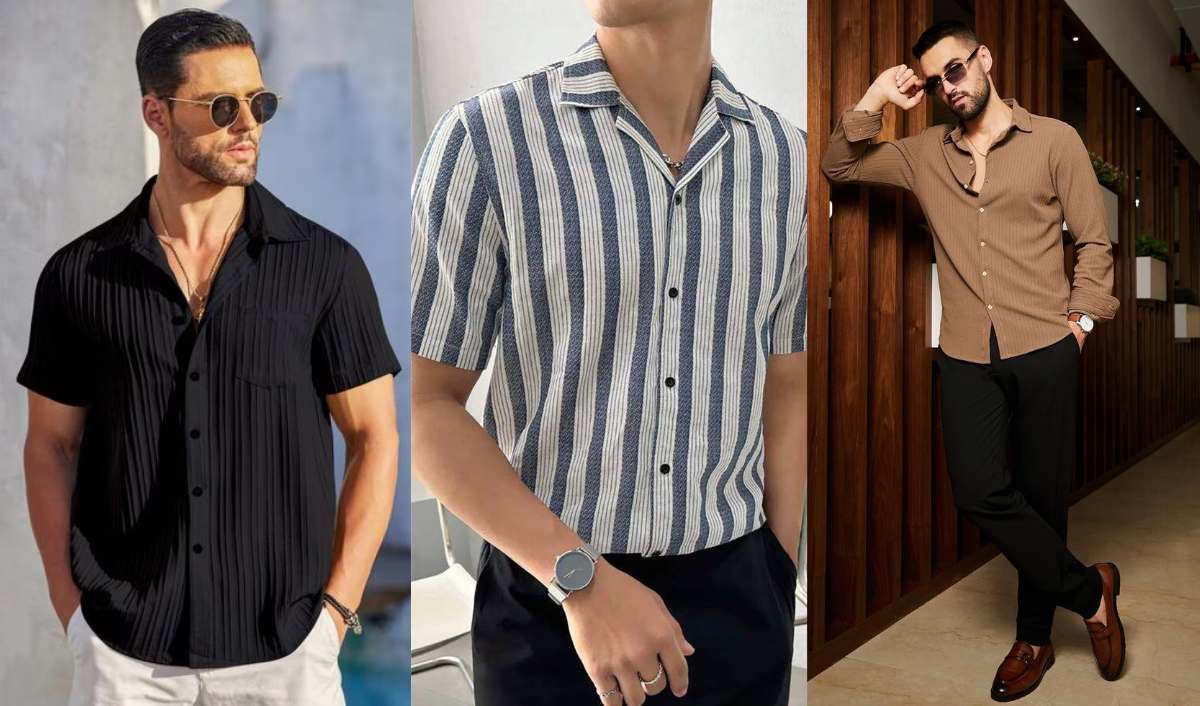Men are simple. They buy a shirt even if it simply feels premium, and comes with a “designer” tag that seems to justify the price. But after a couple of washes, it’s dull, limp, and doesn’t sit on your body the way it did on day one.
This doesn’t mean all premium shirts are a waste of money. It means you need to know what exactly you’re paying for, especially when it comes to the fabric.
This guide is for first-time buyers who want their shirts to look good and stay that way. It breaks down popular fabric types, explains how they behave with time, and offers simple checks to avoid overpaying.
The Poplin Trap: Crisp, But Not Always Built to Last
Poplin has a clean, smooth texture that makes it a go-to for formal shirts. It feels light, irons well, and sits close to the body without clinging. For solids or office wear, it works beautifully.
But poplin comes with a limit, especially when printed shirts are involved. The same tight weave that gives it that neat finish also makes it less absorbent when it comes to dyes. So if you’re buying a printed poplin shirt, expect it to lose sharpness quicker than you’d like. The print sits on the surface and can start looking washed out with regular use.
A quick touch test helps. If the fabric feels overly slippery or makes a faint rustle when you move it, there’s a good chance it has synthetic blends and that affects durability.
Satin’s Shine Doesn’t Always Age Well
Men designer shirts are often picked for their rich, slightly glossy appearance. Whether you’re dressing for a night out or just prefer a smoother texture, they carry a certain visual weight.
But satin is created with the same intention. Some brands achieve the shine using polyester-heavy blends that look sleek at first but wear out fast. These shirts may start pilling, losing their polish, or feeling rougher after a few rounds in the wash.
If you’re buying satin, aim for cotton-based or silk-based versions. They feel soft, breathe better, and retain their subtle shine longer. Over-the-top shine is often a red flag — real satin reflects light softly, not like plastic wrap.
Cotton-Silk Blends: Elegant, but Demanding
These blends are becoming more common in higher-priced shirts. When done right, the result is elegant! Soft on the skin, breathable like cotton, but with the refined drape and finish of silk.
But blends like these need care. If the silk content is too high or untreated, the shirt may lose shape, wrinkle easily, or require dry-cleaning to avoid damage. If you’re someone who tosses everything into one wash cycle, this fabric might test your patience.
Still, for occasions or lighter use, cotton-silk blends in men’s designer shirts can feel noticeably better than plain cotton. When trying them, go by feel. A good blend will be soft without being clingy, structured without feeling stiff.
Printed Shirts: It’s Not Just About the Design
A great print can carry a designer shirt, but how that print is applied matters more than many people realise.
Cheaper printed shirts often use surface-level printing techniques. These are quicker to produce but tend to fade fast. Over time, the design can lose detail or start cracking, especially if the shirt is made with a very thin base fabric.
On the flip side, reactive prints or yarn-dyed fabrics (where the thread itself is dyed before weaving) tend to last much longer. The print looks richer and stays consistent across washes.
One easy way to gauge quality is to flip the shirt inside out. If the print looks equally rich on the inside, you’re likely looking at a better product. If it fades out or looks unfinished, that print is probably going to wear down fast.
Construction Still Matters — Even at the Fabric Stage
Fabric quality is only half the story. If the stitching, buttons, and finishing don’t hold up, the shirt’s going to disappoint quickly.
Things worth noticing:
- Are the seams clean, flat, and evenly stitched?
- Do the collars and cuffs keep their shape or already look soft and floppy?
- Do the buttons feel solid and well-secured, or are they hanging by a thread?
Even premium fabrics can feel average when construction is poor. Good tailoring adds polish and helps the shirt hold structure through wear and wash.
The Price-Tag Illusion: What Are You Actually Paying For?
That ₹5000 price doesn’t always reflect the quality of fabric or build. Sometimes you’re paying for:
- Designer positioning
- Imported branding
- Marketing markup
And that’s fine, as long as the quality matches. But more often, it’s all packaging and the fabric doesn’t justify the cost.
Here’s a better way to frame your decision:
Ask what the shirt will look like after five washes, not just at the time of trial. If the fabric choice, weave, and construction point to long-term wear, the price holds up. If not, it’s just good design on borrowed time.
To Wrap Up
A good shirt doesn’t just look good on Day One. It’s supposed to hold shape, keep its texture, and still feel like a favourite even after regular use. That comes from understanding fabric beyond buzzwords.
You don’t need to become a textile expert. Just remember:
- Poplin is great for clean solids, but weak with surface prints
- Satin’s quality depends on its base fiber, avoid plastic shine
- Cotton-silk blends feel luxurious, but need care
- Prints should feel like part of the fabric, not pasted on top
- Construction is where fabric proves its worth
Your next shirt shouldn’t be a gamble. It should be a choice made with clarity and worn with confidence.

